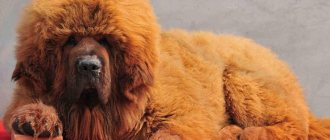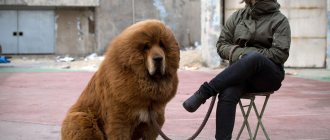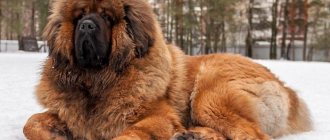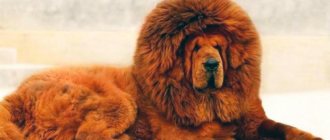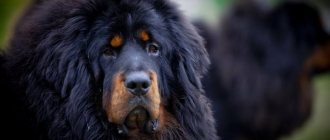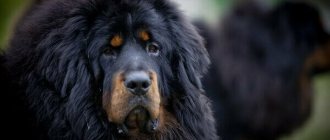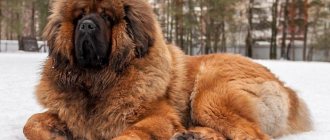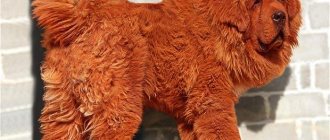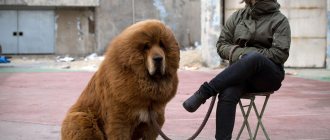The Tibetan Mastiff is rightfully considered one of the largest dog breeds on the planet. And these are truly giants among canines. They not only have an impressive size and muscular body, but their large, powerful head and voluminous fur make their size even more intimidating. Despite their enormous size, the dogs are very harmoniously built, have a muscular but lean body and move actively and deftly.
Description of the breed
The Tibetan Mastiff is a strong and robust dog that is well built and has strong bones. Development occurs slowly: full maturity in females is achieved at 2 - 3 years, in males - not earlier than 4 years. External characteristics of the mastiff:
| Appearance | Characteristics |
| Head | powerful, heavy, wide. The fold goes from eye level to the corners of the mouth; |
| Scull | heavy, large, slightly rounded, the back of the head is pronounced. The stop is clearly visible; |
| Nose | dark, wide, nostrils well open; |
| Muzzle | wide, deep, well filled. At the end the muzzle is square; |
| Lips | pigmented, well hide the lower jaw, well formed; |
| Jaws | powerful, strong, correct bite: the teeth on top overlap the teeth below. The jaw shape is square. Direct bite possible; |
| Eyes | medium, brown, depending on coat color. The eyes are set wide, the shape is oval, slightly slanting. The eyelids fit well to the eyeballs; |
| Ears | the middle ones, in the shape of a triangle, are located between the line of the skull above and the line of the eyes. They fall down and hang close to the head; when the dog is alarmed, they are in the front; |
| Neck | muscular and strong, slightly curved. |
| Frame | strong, back straight and wide, muscular. The croup is flat but wide. The chest is of medium width, deep, the ribs are well formed. The chest is shaped like a heart; |
| Tail | medium, set high, in line with the level of the back. The dog carries it high, bends it freely behind its back while moving; |
| Forelegs | Well developed, curved, strong and muscular. Shoulders well set, forearms straight, bones well formed, ankles strong, slightly sloping; |
| Hind limbs | muscular, strong, curved. The thighs are strong and long, the muscles are well developed, strong, the hocks are strong, set low; |
| Paws | in a lump, large, round. |
The dog's movements are authoritative, flexible, the step is firm and confident. High speed of movement develops in a straight line.
Sizes of puppies compared to humans
Height and weight of small representatives of the breed by month:
- Newborn – 500 g and 10 cm.
- 1 month – 3 kg and 24-28 cm.
- 2 month – 10-11 kg, 30-33 cm.
- 3 months – 15-25 kg, 40-45 cm.
- 4 months – 20-30 kg, 44-47 cm.
- 5 months – 28-40 kg, 52-60 cm.
- 6 months – 30-47 kg, 55-65 cm.
- 7-8 months – 34-50 kg, 60-67 cm.
- 9-11 months – 46-56 kg, 62-69 cm.
- 12 months – 53-60 kg, 70-75 cm.
Height at the withers does not change much as the dog ages. Puppies, like adult dogs, are significantly shorter than humans, but due to their lush fur and muscular build, mastiffs give the impression of huge animals.
Pros and cons of the breed
- excellent watchdog and security qualities;
- peacefulness, friendliness;
- good adaptation to all conditions;
- unpretentiousness in nutrition;
- easy care.
- not adapted to life in cramped apartments;
- heavy shedding;
- increased salivation;
- volume;
- stubbornness.
You can combat the disadvantages of the Tibetan from early childhood, so there won’t be any special problems with puppies.
What determines life expectancy?
The lifespan of a dog of any breed depends on many factors. In order for your pet to delight your family with its presence for a long time, you need to take care of providing it with everything it needs.
Lifespan is affected by:
- accommodations;
- duration and nature of walking;
- food quality;
- physical exercise.
A Tibetan needs a spacious enclosure on a site with a large, comfortable booth and an awning that provides shade on a hot day. You also need a large area, sown with grass or covered with sand, where the pet will walk and play in his free time from the enclosure. For an animal that permanently lives in an enclosure, one long walk a day will be enough.
Important! You should not buy a mastiff puppy if its life will be spent in an apartment. The premises are not very suitable conditions for keeping such a large dog.
For Tibetans, physical activity is important. This is not a guard dog that is put on a chain and sits in one place for days on end. They are smart and resourceful; when trying to close it in the enclosure on a permanent basis, the pets will find a way to open the door or break the bars.
Peculiarities
This breed is not suitable for city apartments - it grows to enormous sizes. Dogs of this breed have been recorded weighing in excess of 100 kg on numerous occasions, so it is important to provide plenty of free space. They are active in the evening and in the morning, this is important to take into account when choosing a puppy. This is an intelligent and independent breed that needs early socialization. A confident person, a leader, must train and raise a puppy. This animal is not suitable for small children - its size is too large. In addition, he may misunderstand some of the children's actions. Adapts well with other dogs and cats if raised in the same house with them.
Myths and legends about the largest Tibetan mastiffs
Alabai Bulldozer: the largest Central Asian Shepherd in the world
Representatives of the breed are surrounded by a huge number of myths and legends. In ancient times, it was believed that the massifs were the descendants of predators: wolves, even jaguars. Science has proven that there is not a word of truth in this legend.
Man's best friend
Another popular myth is that mastiffs have a telepathic connection with their owner. It is difficult to judge telepathy, but these dogs really subtly sense the mood of their owner and try not to bother him.
The Romans and Greeks used dogs in the arena, and the animals became participants in gladiatorial fights. However, in fact, the mastiff's character is very good-natured. This is an affectionate and gentle giant dog who adores his owner.
When hunting, one mastiff can replace a whole row of 20 greyhounds, since it is distinguished by remarkable physical strength and endurance.
Nutrition
Mixed food for this breed is strictly prohibited. If the owner’s choice is dry food, premium or super-premium, holistic is preferable. When feeding natural foods, give preference to the following products:
- lean meat (chicken, rabbit, turkey, beef);
- cereals (buckwheat and rice);
- quail eggs;
- fermented milk products (cottage cheese, kefir);
- vegetables and greens.
Mastiffs should not be fed sweets, flour, potatoes, smoked meats or salty foods. It is also not recommended to feed your pet from your table. Be sure to add minerals and vitamins. It is important to emphasize foods containing calcium - this is important for the prevention of rickets.
Owner reviews
Adult Tibetan mastiffs, especially males, have incredible courage, luxurious fur and a mane, almost like a lion. Bitches are distinguished by greater devotion to the family, as well as a more subtle, rich and complex psyche. Bitches, in the process of training, learn commands faster and are not as stubborn as males.
It is important to know! The Tibetan Mastiff is a full member of the family. He takes part in all important events and perfectly senses the changes in the mood of all family members.
Owners of this breed note that dogs are quite distrustful of strangers and do not show distrust of family members. They behave with restraint, but are always ready to protect the owner’s property and himself, while they are calm and balanced. If there are no visible reasons for this, then Tibetan mastiffs are not capable of unmotivated aggression. Despite its enormous size for a dog, this breed gets along well in any family, regardless of the number of residents. As a rule, Tibetan Mastiffs eventually become true friends and companions.
Tibetan Mastiff - All about the dog breed | Dog breed - Tibetan Mastiff
Frequent illnesses and problems
Mastiffs are characterized by good health, but they are susceptible to certain diseases. The most common ones include:
- hip dysplasia;
- entropion of the eyelid;
- elbow dysplasia;
- osteochondrosis;
- hypertrophic neuropathy;
- panostitis;
- autoimmune hypothyroidism;
- rickets.
Many of these diseases can only be cured by surgery. For example, rickets begins at an early age and progresses. It is important for your puppy to have the right diet. To detect any problems in the early stages, it is recommended to take your puppy to the veterinarian.
It’s not enough to just want to own a Tibetan Mastiff – it’s important to understand the full responsibility of this step. You will need the ability to train and raise a dog; it is important to learn to cope with the difficult temperament and character of the breed. With the right investment of time and effort, this big bear will become a good friend and companion, a faithful and reliable guard.
The largest dog that ever lived is the English Mastiff.
The English mastiff Zorba, born in 1981, was the largest dog in history. Its mass was more than 155 kg, and its length from the tip of its nose to the tip of its tail was 251.5 cm.
There are rich people among dogs
Many owners love their pets very much, care for them and cherish them, and even include them in their will as heirs, even if there are human heirs. In the United States alone, the number of dogs that are primary heirs is estimated at more than a million.
The largest dog that ever lived is the English Mastiff.
The English mastiff Zorba, born in 1981, was the largest dog in history. Its mass was more than 155 kg, and its length from the tip of its nose to the tip of its tail was 251.5 cm.
History and interesting facts about the mastiff
The largest dog in the world: giant breeds
The age of the breed is more than 5000 years. Over this long period, the animals remained virtually unchanged. Therefore, the first standard, adopted in 1122 BC. e. is still relevant today. A detailed description of the representatives of the breed was given by Aristotle, who believed that the formidable dog was a cross between a dog and a tiger. The philosopher noted the amazing size and special, deep, muffled bark. Marco Polo, who met a mastiff while traveling in China, was also impressed by the size of the animal.
The original purpose of the stern giant dogs was to protect the property of Tibetan temples. Gradually, the animals began to be considered elite; only wealthy people could have such a pet. Representatives of the breed not only had an impressive appearance, but also remarkable protective qualities, intelligence, and the ability to make decisions. However, the ferocity of the dogs is by no means a legend. Some mastiffs were indeed so formidable that their owners were forced to keep them locked up, letting them out for walks only at night.
Charming face
Tibet was closed to the rest of the world for a long time, which allowed the purity of the breed to be preserved. Animals were not able to interbreed with other breeds. Very rarely they left their homeland, for example, as a valuable gift to the ruler. The acquaintance with the Tibetans took place in the mid-19th century after a huge puppy was presented as a gift to the British Queen Victoria. They named him Siring.
Note! Mastiffs often worked in teams with Tibetan spaniels. The small dogs, sensing a stranger, began to bark loudly, calling for help from their huge partner.
Gradually we managed to get to know the breed better. In 1931, the Association of Tibetan Breeds appeared and standards were determined. However, the years of World War II almost caused the extinction of the breed. Mastiffs were saved, but they are still considered one of the rarest dogs in the world.
How to bathe?
Rules for bathing a puppy:
- Before bathing, be sure to comb your baby, while talking to him affectionately and putting him in a positive mood.
- The water for swimming should be warm, the optimal temperature is 38-39 degrees.
- At the initial stage, you should not fill the bath with too much water, so as not to scare the baby.
- Be sure to use special shampoo and conditioner.
- During the procedure you should be very careful and patient, because the first bath is always stressful for the dog.
- After bathing, rinse your dog thoroughly and dry with a soft towel.
- Be sure to dry your pet with a hairdryer.
How to choose a puppy?
The first thing you should know is that the Tibetan Mastiff is a rare breed, and therefore you can only buy such a dog in a kennel . If you are offered a TM puppy at a market or at a crossing, don’t believe it – it’s a scam.
What to look for when in the nursery:
- Conditions for keeping animals. If conditions are unsatisfactory, leave. There simply cannot be healthy puppies in such a nursery.
- Condition of the mother of the puppies. If the dog looks tired, sick, or too thin, this is a bad sign.
- Examine the puppy carefully. He should be well-fed, active, inquisitive, the baby’s coat should be smooth and shiny, and his gait should be confident. There should be no discharge from the eyes, ears and nose. The puppy should not have club feet or limp.
- If you are new to dog breeding, give preference to a female dog; they are much more docile and easier to train.
- Ask the breeder to show the documents of the baby’s parents, as well as the puppy’s veterinary passport and his card.
Raising a puppy and training
The characteristics of the breed require that puppy training begin in the first months of life, otherwise he will grow into an aggressive, uncontrollable dog. From the seventh week, the baby is ready to explore the world, so you need to take him out into the world as often as possible. Mastiffs are prone to excessive suspicion and can rush at anyone who seems dangerous to them. To avoid unpleasant consequences, the owner must teach the puppy to distinguish a real threat from an imaginary one.
Tibetans remember commands well and carry them out willingly. At the same time, training at home is a bad idea: if it fails, it will be almost impossible to control the inadequate giant. It is better to use the services of professional dog handlers.
Training and raising a puppy should be based on the principles of mutual respect. Successes must be reinforced with treats and affection. It is strictly forbidden to beat a child or use other inhumane methods.
English Mastiff
The English type of mastiff breed is a fairly large representative of the family. An adult male reaches 80 cm at the withers, the height of a female is 70 cm.
The characteristics of the breed describe the following parameters:
- Large and proportionally folded body. The massive head and strong body look appropriate.
- The back is straight, the stomach is tucked. The paws are straight, powerful, parallel to each other.
- The tail is medium in size and thick. Set on low, mostly hanging down.
- Color of different shades. The dog can be fawn or apricot. But the main feature of the breed is the black color of the muzzle, the so-called mask.
- There are moderate folds on the head. The ears hang down and fit tightly to the cheeks.
- The eyes are widely spaced, the iris color ranges from dark brown to black.
The dog needs enough space. Therefore, before you get an English mastiff, you should take care of a spacious enclosure.
Where to buy and how much it costs
The Tibetan Mastiff is the most expensive dog breed. It is almost impossible to buy purebred puppies in Russia. Native red mastiffs are difficult to find even in Europe. The average cost in Europe and the USA is $2,500-13,000 (156,000-814,000 in rubles).
In Russia, you can buy a puppy for 50,000 rubles, but there is no guarantee that it will be a purebred dog and not an unknown mixed breed. A Tibetan mastiff kennel in Moscow or St. Petersburg will set a price tag of 150-300,000 rubles.
List of nurseries:
- Limar (Moscow, Zhostovo village);
- My Golden Lion (St. Petersburg).
Breeders claim the purity of their puppies and sires, but it is recommended to verify the information.
Who is better: Tibetan Mastiff or Alabai
The Tibetan Mastiff and the Alabai have approximately the same height. The difference is that the upper limit of the height at the withers of the Central Asian Shepherd is 78 cm, while in the mastiff it is absent. Alabai is known as the guardian of one family. They do not obey anyone except their owner, which excludes the possibility of using the breed as service dogs. The same can be said about the mastiff.
The Tibetan and the Central Asian Shepherd have comparable protective qualities. The advantages of one breed over another are assessed based on price, preferences in appearance and the availability of official nurseries.
What do newborn puppies look like in the photo and when do they open their eyes?
The bewitched Tibetan Mastiff puppies are practically no different from puppies of other breeds.
Their eyes are tightly closed, there is no hearing and no thermoregulation . Their excretory system is not yet developed enough to go to the toilet and they need their mother’s help.
A healthy puppy has smooth, shiny fur, clear pink skin, and actively fights for its mother's nipple.
The eyes of a little matif begin to open on the 10th day after birth, and by the 15th day he already sees well.
How can an owner prolong a pet's life?
Any pet needs care and love. Mastiffs are no exception. They need to be fed well, with quality food. If this is a balanced food, you need to make sure the quality of the composition. It is better to choose premium brands of dry food.
When feeding natural food, the basis of the diet should be high-quality, environmentally friendly meat, as well as vegetables, fruits, and grains. Don't forget to include fish in your diet. This is necessary for the normal life support of the pet.
Active walks, games in the fresh air, regular grooming - all this should become mandatory and even daily procedures. The pet must be well-groomed and happy. Of course, you need to regularly show him to the veterinarian to exclude the development of complex diseases.
A dog is a big responsibility. In order for a pet to feel good and always be healthy and live a long life, you need to love it and take careful care of it.
Similar articles
How long do purebred animals live?
According to veterinary experts, there is a clear relationship between the breed and the years measured to the animal. It has been scientifically proven that the smaller the dog, the longer its life.
The vitality of representatives of different breeds varies. This is due to human breeding activities. When developing standards, dogs develop and reinforce features that are often unnatural.
Breeding a breed is fraught with complications, which are expressed in hereditary diseases:
- Chihuahua. These cute little creatures are genetically prone to medial dislocations of the kneecaps, elbow joints, and various dysplasias.
- Dachshund. Natural hunters, with a funny long body on short legs, pay with health for such a body structure. Hereditary pathology in dachshunds is intervertebral disc disease.
- Shar-Pei. Not only in this breed of dog, but in all pets with skin folds, the disease entropion, which is essentially an entropion of the eyelid, is common.
- Rottweilers. Strong, brave, fearless, smart. But they are also susceptible to hereditary diseases - aortic stenosis, Rottweiler leukoencephalopathy, follicular lipidosis.
- Pikines. This ancient breed is distinguished by a special eye structure, for which it suffers from a tendency to eversion of the eyelids, cataracts, and corneal ulcers.
Each breed has its own Achilles heel - dogs with flat faces have problems with the respiratory system, with skin without fur - they suffer from allergies, large pets are often diagnosed with diseases of the joints and bones.
Breeders allow for different situations that affect the life expectancy of dogs:
- Inbreeding;
- Exclusion of the factor of natural selection;
- The appearance of the offspring becomes a priority, not health;
- The lifespan of the progenitors of the offspring is not taken into account.
Dogs of breeds that are less susceptible to selection changes, of medium size, without any special appearance, live the longest. These are terriers, shepherds, huskies.
The presence of long-livers in the family is of great importance. If the pet's parents lived to a ripe old age, then it has every chance of a long life. If we talk about numbers, on average, dogs live about 12 years.
Vaccination schedule
Approximate vaccination schedule for a Tibetan mastiff puppy:
| Puppy age in months | Vaccine used |
| 2 | Nobivac PUPPY DP is a complex live vaccine against plague, parainfluenza, enteritis, leptospirosis and hepatitis. |
| 4-6 (after complete change of teeth) | Nobivac DHPPi+ L is a vaccine against the same diseases. |
| 9-12 | Nobivac DHPPi+ L plus Nobivac R (rabies vaccine). |
In the future, such a vaccine is carried out annually throughout the dog’s life.
American Mastiff
A fairly young breed, recognized in 2000, is the American Mastiff. Appeared as a result of crossing the English Mastiff and the Anatolian Shepherd. The purpose of breeding is to match the appearance of the mastiff and eliminate health problems. The external outlines are similar to those of the English Mastiff. The difference is a tendency towards greater muscularity and athleticism.
American Mastiff breed standards:
- the largest height for males is 91 cm at the withers, for females it is 71-86 cm;
- weight 72-91 and 63-81 kg, respectively;
- the head is voluminous, but moderately;
- the presence of several wrinkles on the face, or their complete absence;
- flat forehead with a groove;
- the muzzle is wide and powerful. In some individuals it is elongated, in others it is shortened. The bridge of the nose is smooth, the transition from the forehead is smooth;
- dangling chins covering the lower jaw. The teeth are developed, the bite is scissor-shaped;
- nose flat black;
- the eyes are widely spaced, the iris is dark in color;
- ears – triangular in shape, drooping;
- the tail is long, tapering to the tip;
- the forelimbs are slightly rounded, the fingers are gathered into a ball;
- hind limbs – erect, muscular;
- The coat is short and thick, the color is fawn, apricot or brindle. A black mask must be present on most of the muzzle. The ears may also be black. Small white spots are allowed in the area of the chest, paws and neck.
The breed is characterized as a companion pet. But sometimes huge mastiffs can be overly intrusive, which becomes a big problem for the breeder. If a dog is well brought up, then he is a true companion and a loving family member. Mastiffs get along well with children, are gentle and tolerant. In society, the dog is polite and patient. But he doesn’t crave communication with strangers.
Dimensions and weight
On average, healthy TM puppies at the time of birth have a valley of 20-27 cm and weigh 400-600g.
| Puppy age in weeks | Ongoing processes |
| 1 | The puppy's primary adaptation to the conditions of the surrounding world occurs: temperature and smells. During this period, the baby’s body is dense, elastic, covered with smooth hair. |
| 2 | The beginning of the transition period. The babies continue to grow actively, and by the end of the second week their weight increases 3 times. Towards the end of the second week, the puppies' eyes and ear canals open, and the baby begins to see and hear. The first baby teeth also appear. |
| 3 | At this stage, the puppies are little by little trying to get to their feet and take their first steps. By this age, thermoregulation improves, and the puppies begin to be less jealous of their mother. At the same age, they are allowed to try solid food. |
| 4 | The babies become more inquisitive and active, crawl out of the nest and begin to play with each other. At this stage, the personality of the future dog begins to form. |
